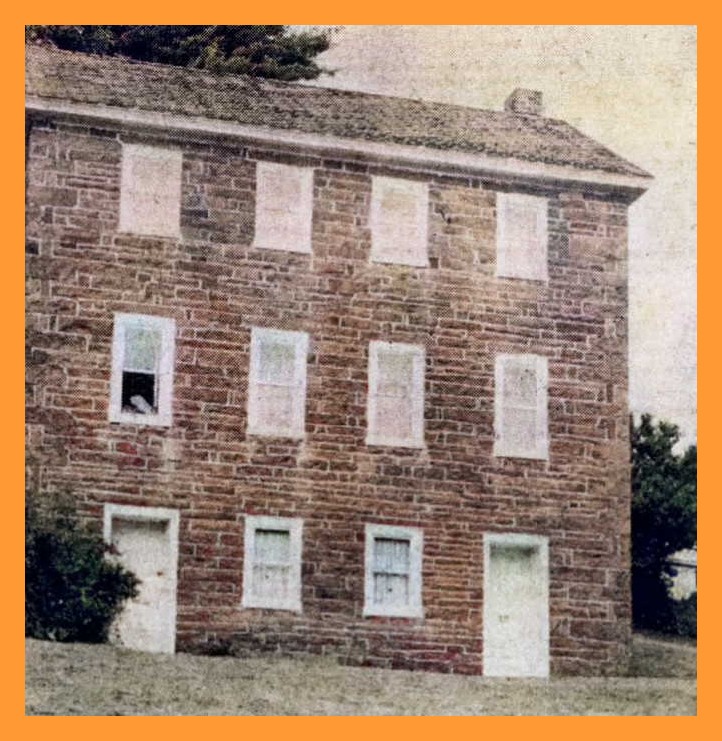
A story that appeared in a Sunbury, Northumberland County, Pennsylvania newspaper in 1975, incorrectly reported on a robbery and shooting that occurred in January, 1876, as a Molly Maguire event. The Nathan Henninger farm was located in Cameron Township, near Shamokin. While four to six men were burglarizing Henninger’s stone house, a gunfire exchange took place, and one of the robbers was killed. Four men were captured and put on trial in Sunbury in March, 1876. All four were found guilty and sent to prison. There was no mention at the trial that the Molly Maguires were involved.
Here’s the 1975 story:
Photo Caption: “SCENE OF ROBBERY, SHOOTING. The above house, in East Cameron Township [Northumberland County, Pennsylvania], built in the early 1800’s, was the scene of a robbery and shooting, according to a Molly Maguire legend, but evidences of the incident are not visible today.”
By Karen Overdorf, staff writer, Sunbury Daily Item, September 12. 1975:
GOWEN CITY – Strange odors, noises and an apparition reportedly occur at an East Cameron Township house that was the scene of a robbery and shooing 99 years ago [1876].
Mrs. Faye Johnson, who lives in the stone house built in the early 1800s, said pleasant aromas can be smelled, apparently coming from upstairs when no one is cooking in the kitchen. Footsteps can also be heard on occasions. Mrs. Johnson said her one son told her several years ago that a “lady in a gray dress” appeared to him during the night.
Mrs. Johnson, who says she believes in the occult, comments that the house is “haunted without reason” and any spirits that may exist are “friendly.”
Before her family purchased the house in 1956, she did not know of the “Molly Maguire” legend concerning the structure. But she is not frightened by the story.
The shooting and robbery were the subject of a 1972 article by Louis Poliniak, a Shamokin historian. According to the story, the home then was occupied by the Nathan Henninger family.
The robbery occurred November 19, 1876 [sic] after Henninger had received $3,000 in gold as an estate settlement. A handyman for the Henningers, Dillard Wright, learned about the money and told Philip Hughes, who was reported to be a Molly secretary from Locust Gap. (The Molly Maguires was an Irish secret society that battled aw enforcement officials over injustices by mine owners in the coal regions of Pennsylvania).
As the story goes, the Henningers had finished their evening meal in their summer house adjacent to the large stone house, when one of them tried to open the door and it stuck. Henninger thrust his weight against the door and it opened revealing a sinister-looking man pointing a gun, Poliniak writes.
The trespasser told Henninger not to come outside onto the snow-covered yard or he would be shot. At the same [time]. several Molly members searched the stone house for the gold and found it in a chest under the floor.
Henninger slammed the door and bolted it to prevent entry to the summer house.
Running upstairs and assisted by the handyman, he saw a man in a white shirt and fired. A dead man later was found near the kitchen door. The man was identified a “Hughes” and Shamokin police were notified of the shooting and in turn telegraphed a message to the Northumberland County sheriff.
It is also said that one of the robbers was shot near an old springhouse outside the house and tracked by bloodstains he left in the snow. It is suspected that the man later died and his body was hidden, Poliniak indicates.
The legend continues that a third an was captured, tried in a court and convicted of being a “Molly.”
Although Wright disappeared the night of the robbery, he returned in 1882 and surrendered to police, Poliniak states. Wright told police he believed the stolen gold was used to provide expenses in a murder trial defense.
Although there is speculation that the money was never recovered, Poliniak contends that it is not buried nearby, since the area was scoured thoroughly.
Constructed with mountain stone and mortared with mud, horsehair, and milkweed pod, the three-story house contains original woodwork and floors although the interior has been remodeled. Mrs. Johnson said chimneys were removed by her family and former owners (of which there were four) and stairways have been changed and rooms divided from the original 21-room house.
The original stone house is connected to a split level wooden addition built later that the early 1800s. The adjacent summer home Mrs. Johnson uses for storage.
Still standing near the house is an old barn reportedly more than 100-feet long and the largest in the area when Henninger lived. Mrs. Johnson said a neighbor stores equipment in the structure.
Because the windows were hand-made, replacement glass is hart to find. Draperies in those sizes are rare. The view appears wavy through several of the windows.
According to some accounts bloodstains of the shooting are visible and a bullet is lodged near a door of the house. Mrs. Johnson says no evidence of this was found when the house was repainted and replastered through the years.
Mrs. Johnson, who is credit and catalogue supervisor at the J. C. Penney Co., Shamokin, said the only reason for which she would ever sell the house was if fuel costs became too high. Her greatest expense in maintaining the large house is for coal, she said.
________________________________________
Obtained from Newspapers.com.
Corrections and additional information should be added as comments to this post.